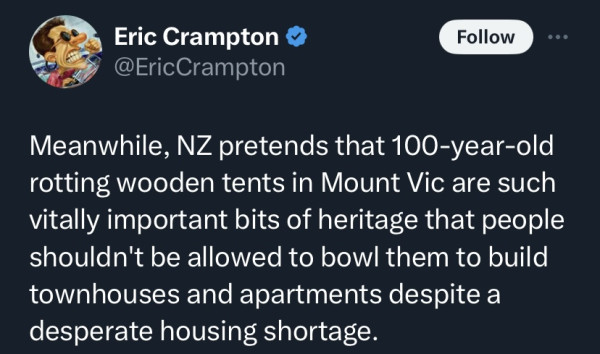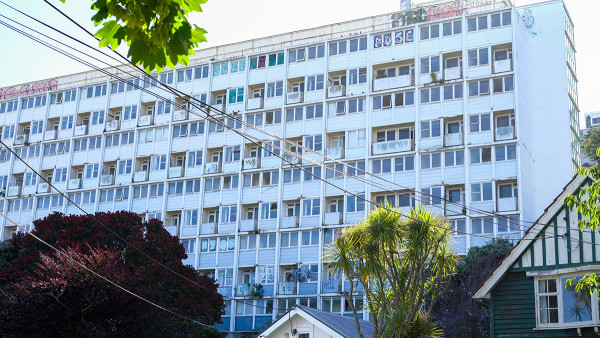There’s around 6000 heritage places across New Zealand but some people don’t believe all of those places add value to their communities.
Town halls, character houses, memorials and churches are some examples of buildings that could be considered heritage.
You might have seen angry posts attacking or defending heritage buildings on social media, or your local council getting backlash or praise for how it handles them.

Social media posts criticising protecting heritage houses. Source: @EricCrampton (X)
So what are heritage buildings and what makes them so controversial?
Re: News spoke to a young documentary maker and people from Heritage New Zealand to break down different sides of this issue.
What is a heritage building?
A building is labelled ‘heritage’ if Heritage New Zealand or a local authority identify that it has great heritage value.
Heritage value can consist of significance, aesthetic, historical and cultural value.
Central region director of Heritage New Zealand Jamie Jacobs says some questions that help decide if a building is heritage or not are:
- How old is it?
- Did an important event happen there?
- Did an important person live or work there?
- Is it loved by the public?
- Is it culturally, religiously or spiritually significant?
- Is it the first building where some structural or design innovation happened?
Why and how are heritage buildings protected?
Jacobs says we protect them because they tell stories and we want to preserve those stories for future generations.
Heritage NZ has a list of heritage places nationwide but they can’t put protections on buildings – only local authorities can.
One way to protect a building is to give it exterior protection.
It means owners cannot make significant changes to the outside of the building without getting resource consent, which is written approval from their local council.
Documentary maker Nate Oakley is critical of heritage buildings
Nate moved from England to New Zealand five years ago and says he spent a lot of that time struggling to find a good place to live and watching renters compete over “shitty places”.
That put him on a path of researching heritage buildings and understanding how they could be connected to the housing crisis.

Nate Oakley is a documentary maker based in Wellington. Photo: supplied
Nate is about to launch Under the Surface, a short documentary that he hopes will prompt people to think about the place of heritage buildings in modern day New Zealand.
Nate says he sees some of the value heritage buildings have, like the vibrancy they add to neighbourhoods, but thinks protecting them shouldn’t be more important than building new housing.
What connects heritage buildings to the housing crisis?
Nate says some heritage houses haven’t been maintained properly so they are uninhabitable and take up valuable space.
Because they are protected, it’s hard to get them knocked down. It’s also very expensive to get them restored and up-to-date with building regulations.
When there is limited land that could be used for housing, it limits the amount of housing people have access to which means people are forced to take whatever they can get, Nate says.
He says landlords charge whatever rent they want because they know renters are desperate, especially young people.
Heritage buildings are taking up space we don't have to spare, Nate says.
In Wellington, 50,000 to 80,000 new residents are expected to move to the city in the next 30 years and Nate says he doesn’t know where these people are meant to live.
“We need to make more room,” he says.
Jacobs from Heritage New Zealand knows there is a housing crisis and says “heritage and densification are not mutually exclusive”.
Jacobs says he wants people to first look at undeveloped or underdeveloped land that could be densified before wanting to destroy heritage places.
He also says a lot of heritage houses exist on expensive land and that if they were replaced with new housing, that housing would not be affordable to first home buyers.
Heritage status protects ‘derelict’ buildings from being demolished
The Gordon Wilson flats is a large heritage building in Wellington that is infamous for its rundown state and has been closed since 2012.

The Gordon Wilson flats are located next to Victoria University of Wellington’s Kelburn campus. Photo: Nate Oakley
The building is located next to a university campus and groups in Wellington have been advocating for it to be demolished or significantly altered and replaced with accommodation or teaching facilities.
Its heritage status prevents that from happening.
But Jacobs says its “derelict” condition doesn’t take away from its heritage value.
He says he has been inside the flats and that it is good housing but doesn’t know how much money it would take to fix the building.
“If the structure is okay, it may be a matter of changing windows and putting in new balustrades… It could be an easy fix,” Jacobs says.
“There are lots of not-well-cared-for buildings but not all are beyond redemption.”
Heritage NZ communications manager Adrienne Hannan says adapting an existing building is better for the environment than demolishing and rebuilding.
Is the Heritage List biased towards Pākehā colonial buildings?
Documentary maker Nate says Pākehā settlements were the only buildings given heritage status for a long time.
“There’s a lot of erasure [of other cultures] here … if we only focus on Pākehā history, that is the only history we will remember,” he says.
But Jacobs says heritage lists all over the world are skewed towards what rich, light-skinned men thought was important but that New Zealand’s list has been diversified.
He says he hopes the list will be “a record of what we valued over time” and that people don’t think it has outlived its usefulness.
Hannan says Heritage NZ is “actively including sites that are significant to Māori and other groups, like Chinese and Indians,” Hannan says.
Should the public decide what is ‘heritage’ in their community?
Nate says communities should get to vote on which buildings to keep protecting and which ones to knock down and replace.
They could decide this based on what buildings they find meaningful and what history they want to remember, he says.
But Nate and Jacobs both say there is no guarantee a demolished heritage building will be replaced by dense and affordable housing because developers make decisions based on what is most profitable.
Jacobs says communities are consulted by councils when new buildings are put on the heritage list and that around 90% of nominations to the list have been made by the public.
“I don't philosophically believe in taking things off the list,” he says.
“Would you rather us spend time adding places that are important to you or spend time taking things off the list?”
Why should young New Zealanders care about heritage houses?
Nate says young New Zealanders have the biggest stake in heritage houses because most of us don't own our own houses and we need places to live.
“The people advocating for heritage houses already own their own homes,” he says.
He wants to see more high rise accommodation being built around central cities so that more people can live closer to their necessities.
Nate says we can’t keep expecting people to live far out from central cities and force them to spend a lot of time commuting to university or work because it will push young people away from opportunities.
He hopes more young people will learn about heritage houses and question what needs to be done about them.
More stories:
$1.9 billion was invested into mental health. Has it made a difference?
Here’s what a new report says.
Should men pay for dates with women?
34% of our audience says yes, 66% says no.
New year, new tenancy? What landlords can and can’t make you do
Here are a few things to be aware of when navigating a rental agreement.